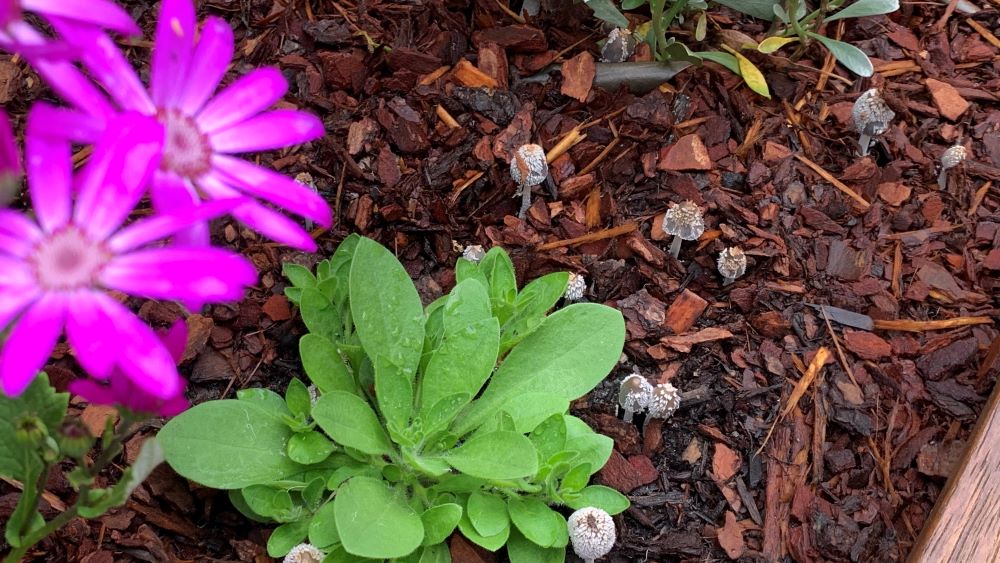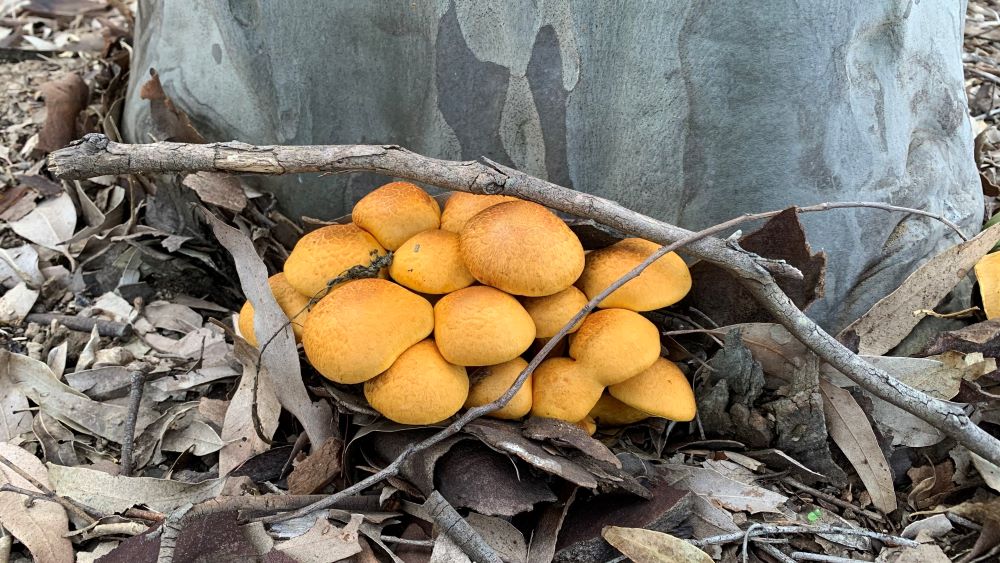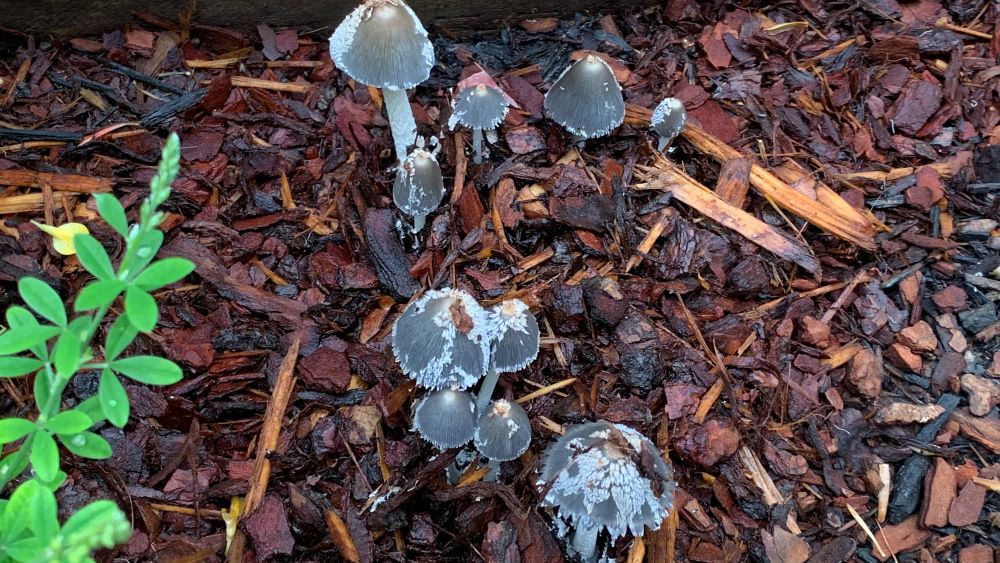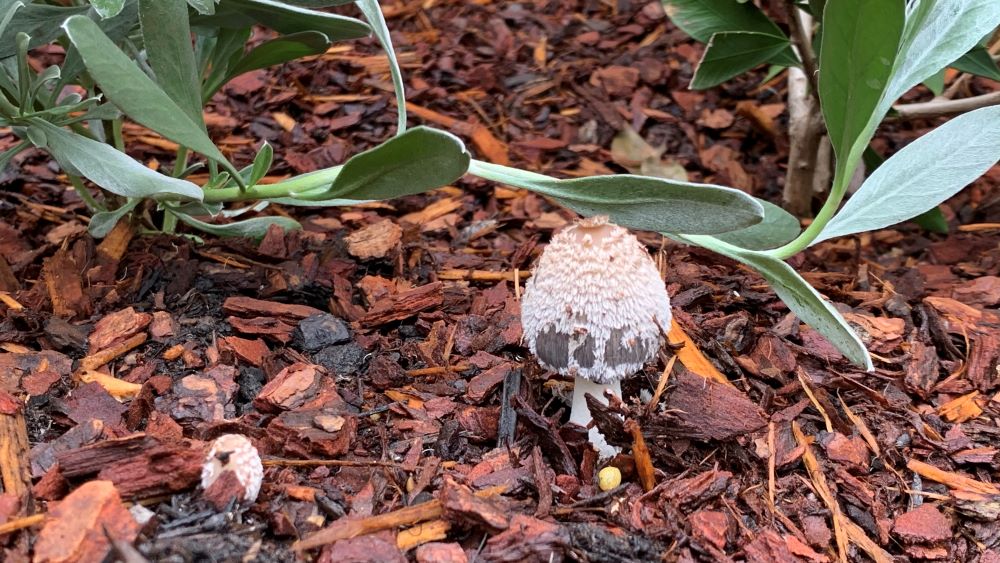Mushrooms can grow rapidly after rain and appear overnight as large as 3-4 inches high. Mushrooms will sprout out of the ground in damp conditions from the mycelium organism that is living in the ground. Growing mushrooms are how this fungus reproduces so they can grow rapidly to release their spores.
Fungus can spread quickly after the mushrooms have formed. You can remove the mushrooms with a small spade and throw them in the bin or leave them there and they will eventually die off.
If the mushrooms are left in the garden bed the spores can be dropped into your soil and they may reappear when the temperature and moisture levels are right.

Mushrooms or toadstools usually love mild weather like spring or fall and damp conditions from the rain. This is why they often appear rapidly during spring rain.
Spores can actually be spread in rain as the raindrop launches on the mushroom and the spore is flung into the air.
This can spread them to other parts of your garden bed or even further into your garden. While fungus like mushrooms and toadstools will not cause any harm to your plants or flowers they can be poisonous if consumed by humans or dogs.
For the safest option remove them with gloved hands and a small space and throw them in the bin.

Where do the mushrooms come from?
There are three main sources of mushroom spores that might appear in your garden after rain. They can be floating around in the air, carried by the rain, laying dormant in the ground soil or be hiding in compost.

Mushroom spores can be floating around in the air and carried by rain
Mushroom spores are microscopic so you can’t see them but they are easily carried by the wind and rain. Raindrops can pick up spores from the air and drop them onto your garden bed. Here they can grow into full sized mushrooms or toadstools within a day.

Laying dormant in the organic matter or ground soil
Mushroom spores or the mycelium (fungus) can be living in the soil under the ground. When the conditions are right the mycelium can grow mushrooms through the soil.
Warmth and moisture are usually the ingredients needed to encourage mushrooms to grow. For me it took a heavy day of rain before my whole raised garden bed was covered with mushrooms. This garden bed had brand new potting soil that was likely to have contained the fungus.

From mushroom compost
Mushroom compost or the discarded material from mushroom farming can be used in potting soil mixes. This can carry a range of mushroom spores which can regrow after heavy rain. While you could grow the original edible mushrooms they are more likely to be carrying toadstool spores that are poisonous to eat.
You can buy mushroom compost in bags and mix them into your garden beds to add organic matter. Sometimes fungus sprouts can appear after this has been mixed through.

Do mushrooms grow after rain?
Mushrooms or toadstools are fungi that can grow after rain in your garden bed. Soil or compost that contains fungus spores can spring to life. Most soil will hold fungal spores that can grow quickly when the weather stays damp.
These mushrooms or toadstools can be a range of colors, sizes and shapes and can be deeply fascinating to watch grow.
Mushrooms can also grow from mulch which can carry spores from the environment that they were grown in. Organic material like bark mulch, aged manures or compost can often carry mushroom spores.

How fast do mushrooms grow after rain?
After rain mushrooms can appear very fast due to their unique life cycle. The rain triggers the release of spores, which settle in moist environments. Mushrooms can appear as fast as 1 hour after rain if the soil has already been moist and the mycelium has already established.
The mushrooms appear from the mycelium—the fungus’ thread-like structure that grows beneath the surface. Most mushrooms will grow within a few days of rain, depending on species, temperature, and humidity.
The fastest-growing mushrooms after rain are typically species belonging to the genus “Psilocybe,”. These mushrooms are known for their rapid growth and can emerge within a few days of heavy rainfall, particularly in warm and humid environments.
Keep in mind that collecting and consuming wild mushrooms can be dangerous without proper identification expertise and medical guidance. It is best not to eat any mushroom you find growing outside in your yard or elsewhere.
Do fairy ring mushrooms grow after rain?
Fairy ring mushrooms can grow after rain. These unique mushrooms are known for forming circular patterns in lawns or grassy areas. Rainfall can cause them to grow by providing the moisture necessary for fruiting.
Whether or not fairy ring mushrooms appear after rain will also depend on the soil conditions, temperature, and the specific species of mushrooms involved so they won’t always pop up after rain.
Are mushrooms that grow after rain poisonous?
A wide variety of mushrooms that are both edible and toxic can grow after rain. It is very hard to tell the difference which is why it is best not to eat any mushroom that you have found growing outside.
Eating wild mushrooms carries significant risks due as they are hard to identify accurately. Many edible mushrooms have toxic look-alikes which makes them very risky to eat. Without expert knowledge, distinguishing between safe and poisonous varieties can be extremely challenging.
Even subtle differences in color, texture, or other characteristics matter. Ingesting toxic mushrooms can lead to severe illness or death. It’s recommended to avoid consuming any wild mushrooms. Relying on store-bought, cultivated mushrooms is the safest way to enjoy them.
Why do mushrooms suddenly appear?
Mushrooms will suddenly appear overnight or early in the morning after rain has fallen or if you have watered your garden bed a lot. Mushrooms or toadstools usually need a lot of water to sprout and grow.
Most mushrooms will grow quickly so they can rapidly reproduce spores can be carried by the wind or rain and spread to other areas of your yard or even neighborhood.
How long do mushrooms take to pop up after rain?
Mushrooms can pop up overnight when it has been raining and the weather is warm. They can also pop up a few days after rain has stopped if the soil stays damp. Mushrooms can disappear as quickly as they grew. Within a day a mushroom can appear and rot back into the ground.

Should you remove mushrooms after rain?
Removing mushrooms after rain can be a good idea if you have dogs or kids around. This avoids them accidentally eating or touching a mushroom that might be poisonous.
Removing mushrooms or toadstools can also help to reduce the spread of them through your yard. While they won’t do any damage to your plants they can become unsightly and pop up again when it rains.
Why mushrooms grow after rain | Summary
Mushrooms grow after rain as the damp conditions can encourage fungus in the soil to sprout mushrooms or toadstools. This is how the fungus reproduces as the mushroom will be holding fungal spores. These can be spread again and wait dormant in the soil or grow new mycelium and mushrooms.
References:
Frazer, 2016, Scientific American, Made by Rain, Mushrooms Also Make It, accessed 13/10/21, https://blogs.scientificamerican.com/artful-amoeba/made-by-rain-mushrooms-also-make-it/
I am an accredited practicing dietitian, experienced gardener and a dedicated cook. I love writing and sharing my experience so you can learn from my successes and mistakes.
